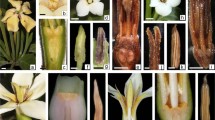Abstract
Based on the literature, we assumed the presence of several morphological forms of flowers of the dioecy species Antennaria dioica (L.) Gaertn. We investigated 6000 flowers from three sites in Europe. As a result of this study, we allocated three morphological types of flowers: female, male, and hermaphroditic (2.5% sample). Variability of the degree of reduction of different organs, especially in the case of male flowers, was detected.
Similar content being viewed by others
References
Barkley, T.M., Brouillet, L., and Strother, J.L., Asteraceae, in Flora of North America, Oxford: Oxford Univ. Press, 2006, vol. 19, pp. 3–16.
Bayer, R.J., Antennaria dioica, in Flora of North America, Oxford: Oxford Univ. Press, 2006, vol. 19, p. 406.
Bayer, R.J. and Stebbins, G.L., Chromosome numbers, patterns of distribution and apomixis in Antennaria (Asteraceae: Inuleae), Systemat. Bot., 1987, vol. 12, no. 2, pp. 305–319.
Borisova, A.G., Antennaria, in Flora SSSR, Shishkin, B.K., Ed., Moscow: Izd. AN SSSR, 1959, vol. 25, pp. 333–334.
Case, A.L. and Barret, S.C.H., Environmental stress and the evolution of dioecy: Wurmbea dioica (Colchicaceae) in Western Australia, Evol. Ecol., 2004, vol. 18, no. 2, pp. 145–164.
Charlesworth, D., Plant sex determination and sex chromosomes, Heredity, 2002, vol. 88, pp. 94–101.
Delannay, X., Cytological study of dioecy in Cirsium arvense, Phytomorphology, 1978, vol. 27, no. 4, pp. 420–425.
Desfeux, C., Maurice, S., and Henry, J.-P., Evolution of reproductive systems in the genus Silene, Proc. R. Soc. Lond. B, 1996, vol. 282, no. 1802, pp. 409–414.
Dorken, M.E. and Barret, S.C.H., Sex determination and the evolution of dioecy from monoecy in Sagittaria latifolia (Alismataceae), Proc. R. Soc. Lond. B, 2004, vol. 282, no. 1802, pp. 213–219.
Doust, J.L. and Doust, L.L., Plant Reproductive Ecology: Patterns and Strategies, New York: Oxford Univ. Press, 1990.
Engelskjen, T. and Skifte, O., The vascular plants of Troms, North Norway. Revised distribution maps and altitude limits after Benum “The flora of Troms Fylke,” Tromura Naturvitenskep, 1995, vol. 80, pp. 4–227.
Galli, M., Braeale, M., Falavigna, A., Raffaldi, F., Savini, C., and Vigo, A., Different kinds of male flowers in the dioecious plant Asparagus officinalis L., Sex. Plant Reprod., 1993, vol. 6, no. 1, pp. 16–21.
Geber, M.A., Dawson, T.E., and Delph, L.F., Gender and Sexual Dimorphism in Flowering Plants, Heidelberg: Springer, 1999.
Gleiser, G. and Verdu, M., Repeated evolution of dioecy from androdioecy in Acer, New Phytol., 2005, vol. 165, no. 2, pp. 633–640.
Godin, V.N., Sex differentiation in plants: terms and concepts, Zh. Obshch. Biol., 2007, vol. 68, no. 2, pp. 98–108.
Öster, M. and Eriksson, O., Sex ratio mediated pollen limitation in the dioecious herb Antennaria dioica, Ecoscience, 2007, vol. 23, nos. 3–4, pp. 387–398.
Polunin, O., Flowers of Europe: A Field Guide, London: Oxford Univ. Press, 1969.
Renner, S.S. and Ricklefs, R., Dioecy and its correlates in the flowering plants, Am. J. Bot., 1995, vol. 82, no. 5, pp. 596–606.
Von Ubisch, G., Genetic studies on the nature of hermaphroditic plants in Antennaria dioica (L.) Gaertn, Genetics, 1936, vol. 21, no. 3, pp. 282–294.
Varga, S., Effects of arbuscular mycorrhizas on reproductive traits in sexually dimorphic plants: a review, Span. J. Agric. Res., 2010, vol. 8, pp. 11–24.
Varga, S. and Kytöviita, M.-M., Sex ratio and spatial distribution of male and female Antennaria dioica (Asteraceae) plants, Acta Oecolog., 2011, vol. 37, no. 5, pp. 433–440.
Author information
Authors and Affiliations
Corresponding author
Additional information
Original Russian Text © K.V. Dudova, 2018, published in Izvestiya Akademii Nauk, Seriya Biologicheskaya, 2018, No. 1, pp. 22–27.
Rights and permissions
About this article
Cite this article
Dudova, K.V. Morphological Variability of Flowers of Antennaria dioica (L.) Gaertn.: Circumstantial Evidence for the Origin of Taxon Dioecy from Hermaphroditism through Gynodiecy. Biol Bull Russ Acad Sci 45, 18–22 (2018). https://doi.org/10.1134/S106235901801003X
Received:
Published:
Issue Date:
DOI: https://doi.org/10.1134/S106235901801003X




